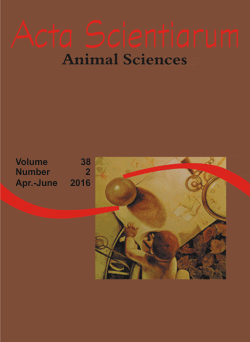<b>Association between periphyton and bioflocs systems in intensive culture of juvenile Nile tilapia
Resumo
The present work aimed at determining the effects of the association between the periphyton-based system with the bioflocs-based system in the intensive culture of juvenile Nile tilapia (1.56 ± 0.07 g; 72 fish m-3), on variables of water quality, growth performance and effluent quality after 10 weeks. The experiment was arranged in a 2 x 2 factorial randomized block design with four treatments and five repetitions each. The factors tested were the following: ‘underwater structure’ (absence and presence) and ‘adjustment of the C: N ratio of water’ (no and yes). The final fish body weight, specific growth rate and yield were higher (p < 0.05) in the C: N-adjusted tanks. The presence of submerged structures in the tanks had no significant influence on those same variables. It was concluded that the periphyton-based system is not indicated for intensive farming of Nile tilapia, in which there is a high allowance of artificial feed to fish.
Downloads
DECLARAÇÃO DE ORIGINALIDADE E DIREITOS AUTORAIS
Declaro que o presente artigo é original, não tendo sido submetido à publicação em qualquer outro periódico nacional ou internacional, quer seja em parte ou em sua totalidade.
Os direitos autorais pertencem exclusivamente aos autores. Os direitos de licenciamento utilizados pelo periódico é a licença Creative Commons Attribution 4.0 (CC BY 4.0): são permitidos o compartilhamento (cópia e distribuição do material em qualqer meio ou formato) e adaptação (remix, transformação e criação de material a partir do conteúdo assim licenciado para quaisquer fins, inclusive comerciais.
Recomenda-se a leitura desse link para maiores informações sobre o tema: fornecimento de créditos e referências de forma correta, entre outros detalhes cruciais para uso adequado do material licenciado.








































